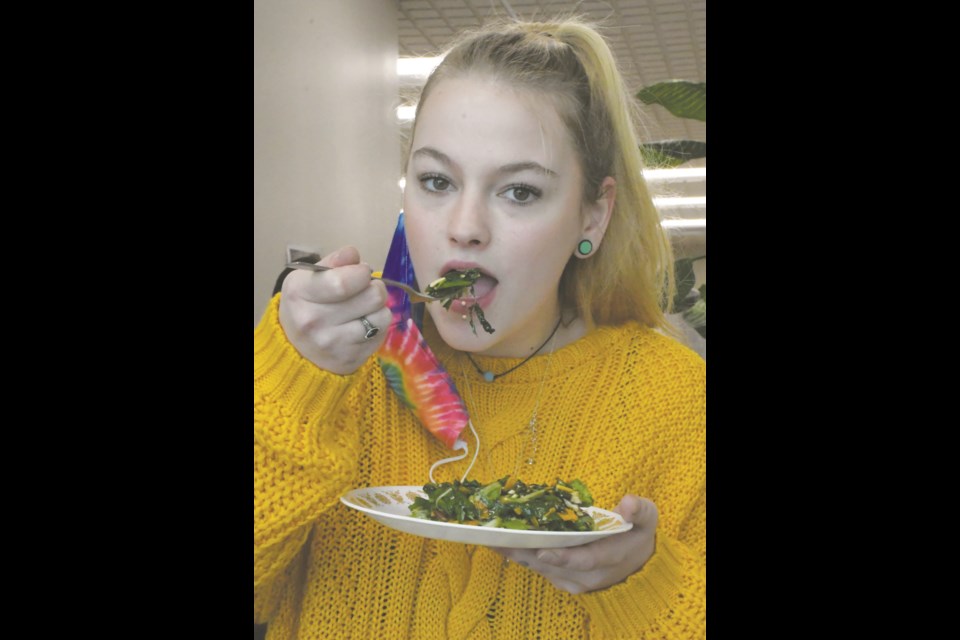After more than a month of managing an indoor garden, students at Phoenix Academy were finally able to taste the fruits of their labour — or vegetables, in this case.
On Feb. 25, the youths heartily dug into a salad made from the plants they grew during the past five weeks, such as micro kale, gourmet lettuce, arugula, broccoli, and rainbow chard. A gooey piece of pizza also accompanied the meal.
The school received $3,000 from the Whole Kids Foundation in December to purchase the equipment and seeds for an indoor garden. Students then purchased and planted seeds in wool pods and two tower gardens in mid-January.
Helping to plant and manage an indoor garden was a cool experience for Grade 11 student Trinity Morrissette.
“I’ve never planted anything before. I’ve definitely never seen one of those (garden tower) machines before,” she said. “I thought it was really cool that we got to try it too.”
Watching how fast the plants grew was a surprising part of the project, she continued. One reason for the fast growth is because nutrients in the water were circulated throughout the tower.
With a fork in hand, Morrissette chewed into the first bites of her salad and gave it a thumbs up.
“It’s really good,” she said, adding she plans to grow a garden at home.
Ashante Sanguais-Bear also thought participating in the project was amazing, although she admitted that she was surprised teachers asked her to help since she is not interested much in group projects.
“But when I heard it was gardening — I grew up gardening with my father. We grew corn, lettuce, everything like that,” she said, adding she applied some of that knowledge to this project. “It was sort of different because I was used to doing it in soil, but this you grow in water.”
Sanguais-Bear also enjoyed eating the freshly picked produce. She, too, was surprised at how fast the plants grew, especially since they planted the seedlings only weeks ago. Based on this experience, she is considering planting a garden this summer.
“I really enjoy it (because) it’s kind of therapeutic,” she added.
Teacher Nichole Cornea explained that many plants exploded in growth over the February winter break. She showed before-and-after pictures of some of the plants, whose leaves grew from the size of a fist to the size of a dinner plate.
Besides nutrient-infused water, the plants also grew quickly because students wrapped an emergency blanket around one tower. This helped the plants grow three times as fast.
“I’ve gardened for years. It’s kind of magic. Like, it was exciting to open up the emergency blankets,” she chuckled.
While growing a garden can be more hard work than enjoyment, there is something about pulling a carrot out of the ground and eating it, Cornea added. The hope is that students will grow gardens at home, especially since food is more expensive.
The harvest occurred after night school on Feb. 24, when nutritionist Lori Hetke realized the produce was wilting since it was so fresh. She cut off the plants with scissors and placed them in an aluminum roaster; the container quickly filled up.
“Kids don’t get the fresh produce at home. They get the breads and fatty stuff (and fried foods),” she said. However, it’s good for them to see the different types of fresh produce and see how it’s grown. “And the taste is so much richer coming off the tower gardens.”
The sunlight from the towers was also healthy for the kids, Hetke added, since it energized them and made school a happier place.
Principal Jeff Lynnes thought the project had value since it helped students learn from where their food comes, while having garden towers allowed for discussions about food security.
“Most lettuce comes from California or Arizona and has to be shipped here … ,” he added. “So, you get to learn that, yeah, you get a head of lettuce cheap, but there’s an environmental cost.”
Lynnes thanked all the project partners, noting the school could not have done it without that generosity.




